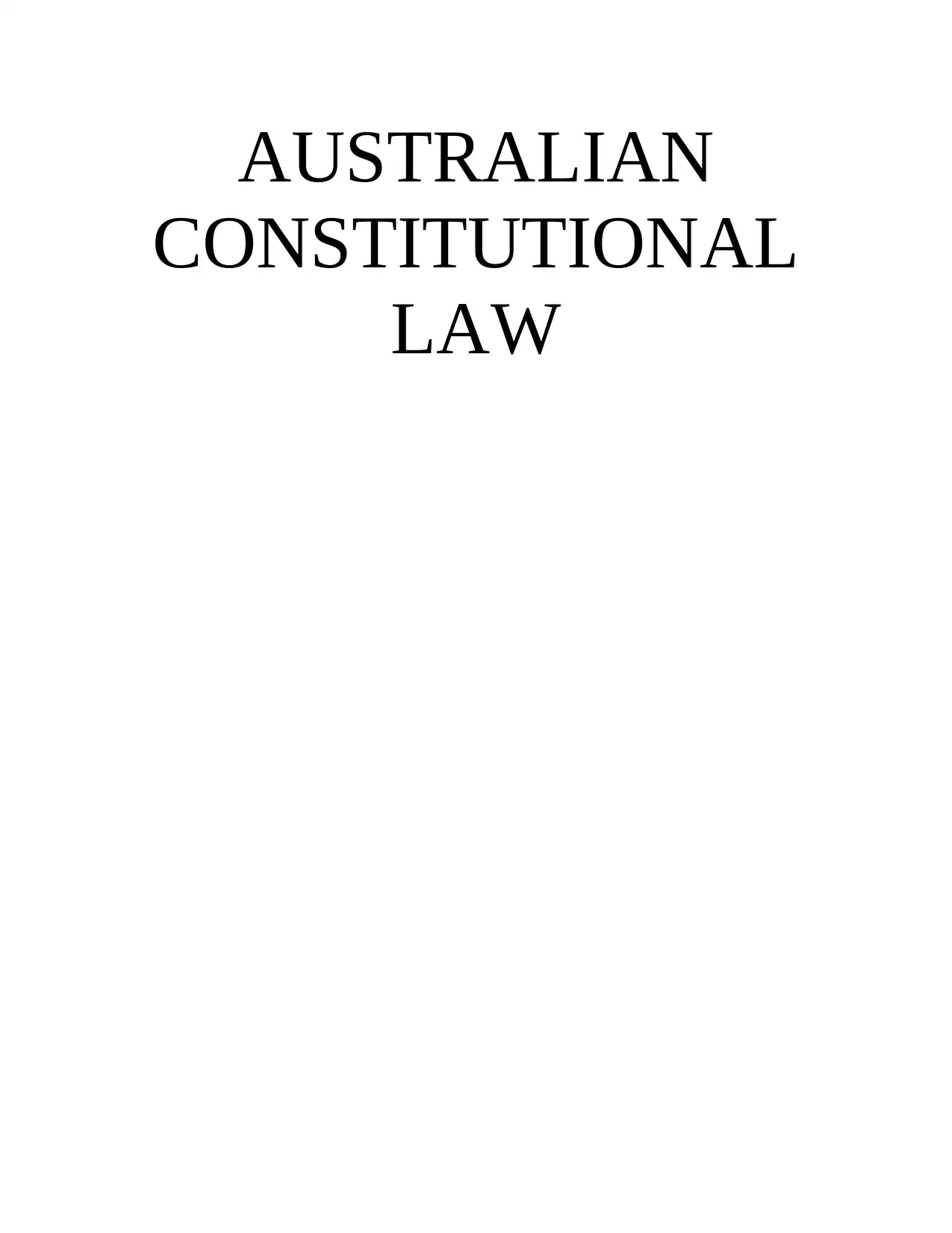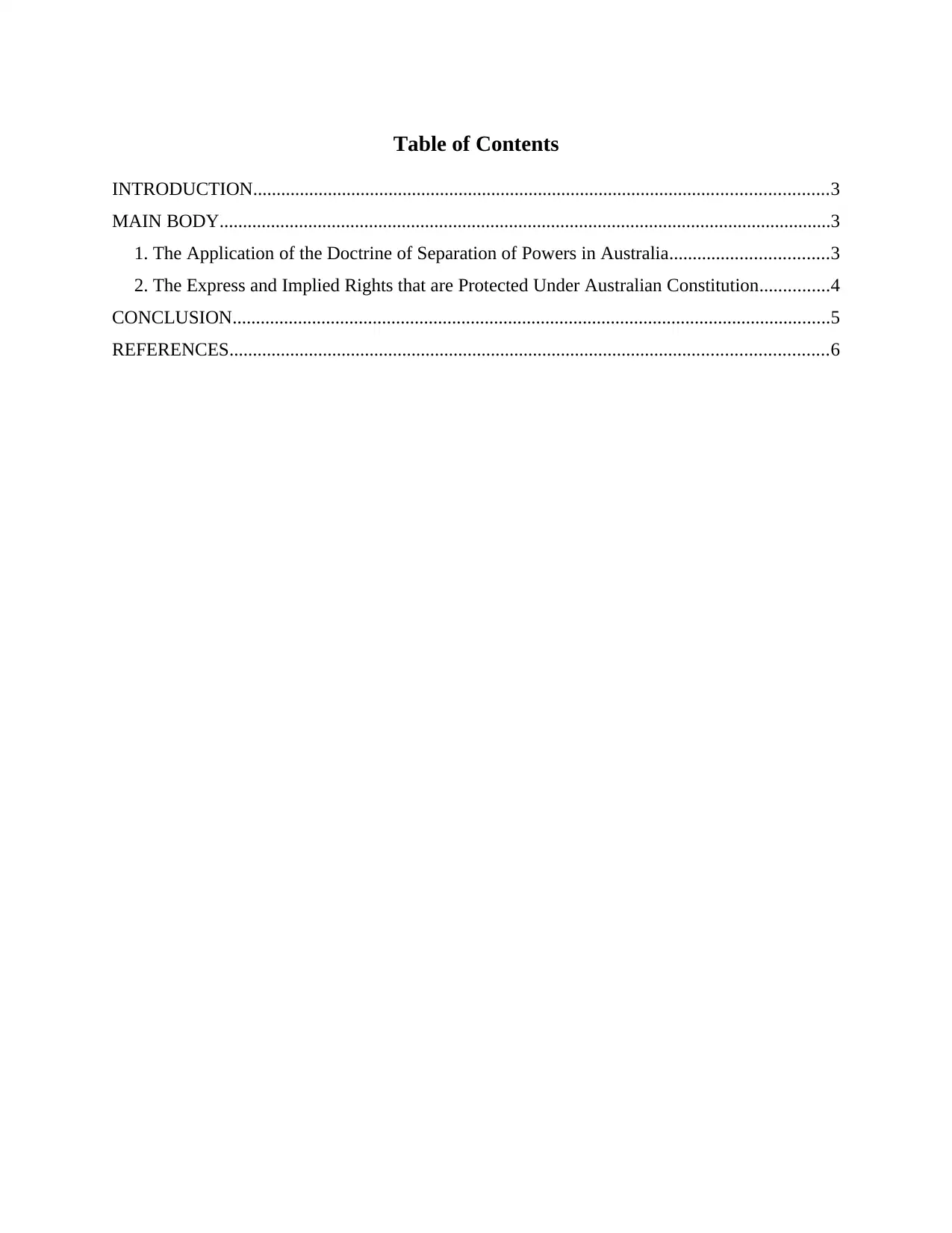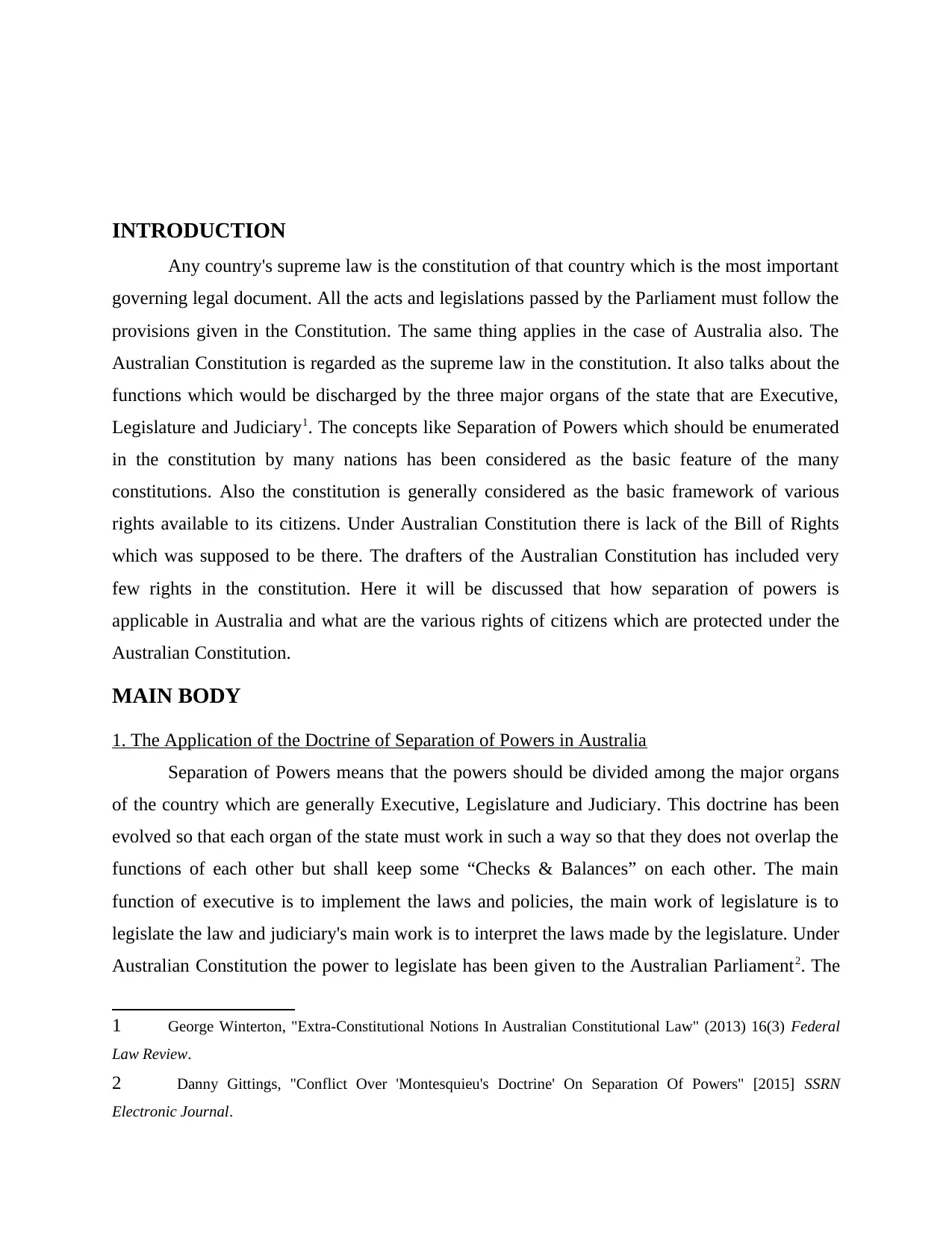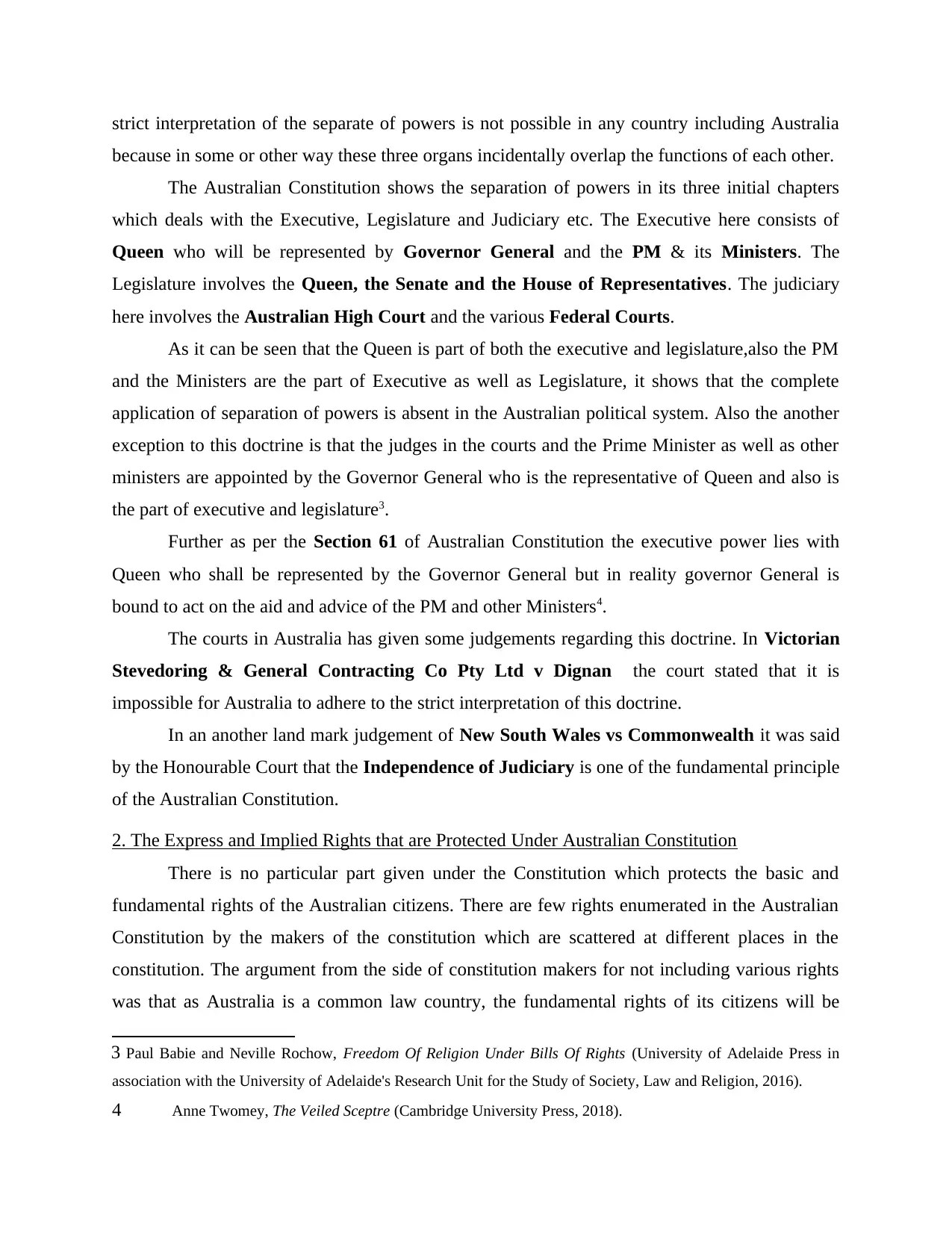Critique of Human Rights in the Australian Constitution - Law Essay
VerifiedAdded on 2023/01/09
|6
|1474
|71
Essay
AI Summary
This essay critically analyzes the extent to which the drafters of the Australian Constitution adequately considered the protection of human rights for Australian citizens. It begins by introducing the Australian Constitution as the supreme law, highlighting the roles of the Executive, Legislature, and Judiciary, and the concept of Separation of Powers. The main body delves into the application of the doctrine of Separation of Powers in Australia, acknowledging that a strict interpretation is not possible due to overlaps, but the Constitution does delineate the powers of the Executive, Legislature, and Judiciary. The essay also examines the express and implied rights protected under the Australian Constitution, noting the lack of a comprehensive Bill of Rights, and discusses the few rights enumerated, such as trial by jury and religious freedom, while also mentioning implied rights like the right to vote. The conclusion emphasizes the limited applicability of complete Separation of Powers and the need for greater explicit protection of rights, advocating for the inclusion of a Bill of Rights for the benefit of the Australian people. The essay includes references to relevant academic sources and case law.

AUSTRALIAN
CONSTITUTIONAL
LAW
CONSTITUTIONAL
LAW
Paraphrase This Document
Need a fresh take? Get an instant paraphrase of this document with our AI Paraphraser

Table of Contents
INTRODUCTION...........................................................................................................................3
MAIN BODY...................................................................................................................................3
1. The Application of the Doctrine of Separation of Powers in Australia..................................3
2. The Express and Implied Rights that are Protected Under Australian Constitution...............4
CONCLUSION................................................................................................................................5
REFERENCES................................................................................................................................6
INTRODUCTION...........................................................................................................................3
MAIN BODY...................................................................................................................................3
1. The Application of the Doctrine of Separation of Powers in Australia..................................3
2. The Express and Implied Rights that are Protected Under Australian Constitution...............4
CONCLUSION................................................................................................................................5
REFERENCES................................................................................................................................6

INTRODUCTION
Any country's supreme law is the constitution of that country which is the most important
governing legal document. All the acts and legislations passed by the Parliament must follow the
provisions given in the Constitution. The same thing applies in the case of Australia also. The
Australian Constitution is regarded as the supreme law in the constitution. It also talks about the
functions which would be discharged by the three major organs of the state that are Executive,
Legislature and Judiciary1. The concepts like Separation of Powers which should be enumerated
in the constitution by many nations has been considered as the basic feature of the many
constitutions. Also the constitution is generally considered as the basic framework of various
rights available to its citizens. Under Australian Constitution there is lack of the Bill of Rights
which was supposed to be there. The drafters of the Australian Constitution has included very
few rights in the constitution. Here it will be discussed that how separation of powers is
applicable in Australia and what are the various rights of citizens which are protected under the
Australian Constitution.
MAIN BODY
1. The Application of the Doctrine of Separation of Powers in Australia
Separation of Powers means that the powers should be divided among the major organs
of the country which are generally Executive, Legislature and Judiciary. This doctrine has been
evolved so that each organ of the state must work in such a way so that they does not overlap the
functions of each other but shall keep some “Checks & Balances” on each other. The main
function of executive is to implement the laws and policies, the main work of legislature is to
legislate the law and judiciary's main work is to interpret the laws made by the legislature. Under
Australian Constitution the power to legislate has been given to the Australian Parliament2. The
1 George Winterton, "Extra-Constitutional Notions In Australian Constitutional Law" (2013) 16(3) Federal
Law Review.
2 Danny Gittings, "Conflict Over 'Montesquieu's Doctrine' On Separation Of Powers" [2015] SSRN
Electronic Journal.
Any country's supreme law is the constitution of that country which is the most important
governing legal document. All the acts and legislations passed by the Parliament must follow the
provisions given in the Constitution. The same thing applies in the case of Australia also. The
Australian Constitution is regarded as the supreme law in the constitution. It also talks about the
functions which would be discharged by the three major organs of the state that are Executive,
Legislature and Judiciary1. The concepts like Separation of Powers which should be enumerated
in the constitution by many nations has been considered as the basic feature of the many
constitutions. Also the constitution is generally considered as the basic framework of various
rights available to its citizens. Under Australian Constitution there is lack of the Bill of Rights
which was supposed to be there. The drafters of the Australian Constitution has included very
few rights in the constitution. Here it will be discussed that how separation of powers is
applicable in Australia and what are the various rights of citizens which are protected under the
Australian Constitution.
MAIN BODY
1. The Application of the Doctrine of Separation of Powers in Australia
Separation of Powers means that the powers should be divided among the major organs
of the country which are generally Executive, Legislature and Judiciary. This doctrine has been
evolved so that each organ of the state must work in such a way so that they does not overlap the
functions of each other but shall keep some “Checks & Balances” on each other. The main
function of executive is to implement the laws and policies, the main work of legislature is to
legislate the law and judiciary's main work is to interpret the laws made by the legislature. Under
Australian Constitution the power to legislate has been given to the Australian Parliament2. The
1 George Winterton, "Extra-Constitutional Notions In Australian Constitutional Law" (2013) 16(3) Federal
Law Review.
2 Danny Gittings, "Conflict Over 'Montesquieu's Doctrine' On Separation Of Powers" [2015] SSRN
Electronic Journal.
⊘ This is a preview!⊘
Do you want full access?
Subscribe today to unlock all pages.

Trusted by 1+ million students worldwide

strict interpretation of the separate of powers is not possible in any country including Australia
because in some or other way these three organs incidentally overlap the functions of each other.
The Australian Constitution shows the separation of powers in its three initial chapters
which deals with the Executive, Legislature and Judiciary etc. The Executive here consists of
Queen who will be represented by Governor General and the PM & its Ministers. The
Legislature involves the Queen, the Senate and the House of Representatives. The judiciary
here involves the Australian High Court and the various Federal Courts.
As it can be seen that the Queen is part of both the executive and legislature,also the PM
and the Ministers are the part of Executive as well as Legislature, it shows that the complete
application of separation of powers is absent in the Australian political system. Also the another
exception to this doctrine is that the judges in the courts and the Prime Minister as well as other
ministers are appointed by the Governor General who is the representative of Queen and also is
the part of executive and legislature3.
Further as per the Section 61 of Australian Constitution the executive power lies with
Queen who shall be represented by the Governor General but in reality governor General is
bound to act on the aid and advice of the PM and other Ministers4.
The courts in Australia has given some judgements regarding this doctrine. In Victorian
Stevedoring & General Contracting Co Pty Ltd v Dignan the court stated that it is
impossible for Australia to adhere to the strict interpretation of this doctrine.
In an another land mark judgement of New South Wales vs Commonwealth it was said
by the Honourable Court that the Independence of Judiciary is one of the fundamental principle
of the Australian Constitution.
2. The Express and Implied Rights that are Protected Under Australian Constitution
There is no particular part given under the Constitution which protects the basic and
fundamental rights of the Australian citizens. There are few rights enumerated in the Australian
Constitution by the makers of the constitution which are scattered at different places in the
constitution. The argument from the side of constitution makers for not including various rights
was that as Australia is a common law country, the fundamental rights of its citizens will be
3 Paul Babie and Neville Rochow, Freedom Of Religion Under Bills Of Rights (University of Adelaide Press in
association with the University of Adelaide's Research Unit for the Study of Society, Law and Religion, 2016).
4 Anne Twomey, The Veiled Sceptre (Cambridge University Press, 2018).
because in some or other way these three organs incidentally overlap the functions of each other.
The Australian Constitution shows the separation of powers in its three initial chapters
which deals with the Executive, Legislature and Judiciary etc. The Executive here consists of
Queen who will be represented by Governor General and the PM & its Ministers. The
Legislature involves the Queen, the Senate and the House of Representatives. The judiciary
here involves the Australian High Court and the various Federal Courts.
As it can be seen that the Queen is part of both the executive and legislature,also the PM
and the Ministers are the part of Executive as well as Legislature, it shows that the complete
application of separation of powers is absent in the Australian political system. Also the another
exception to this doctrine is that the judges in the courts and the Prime Minister as well as other
ministers are appointed by the Governor General who is the representative of Queen and also is
the part of executive and legislature3.
Further as per the Section 61 of Australian Constitution the executive power lies with
Queen who shall be represented by the Governor General but in reality governor General is
bound to act on the aid and advice of the PM and other Ministers4.
The courts in Australia has given some judgements regarding this doctrine. In Victorian
Stevedoring & General Contracting Co Pty Ltd v Dignan the court stated that it is
impossible for Australia to adhere to the strict interpretation of this doctrine.
In an another land mark judgement of New South Wales vs Commonwealth it was said
by the Honourable Court that the Independence of Judiciary is one of the fundamental principle
of the Australian Constitution.
2. The Express and Implied Rights that are Protected Under Australian Constitution
There is no particular part given under the Constitution which protects the basic and
fundamental rights of the Australian citizens. There are few rights enumerated in the Australian
Constitution by the makers of the constitution which are scattered at different places in the
constitution. The argument from the side of constitution makers for not including various rights
was that as Australia is a common law country, the fundamental rights of its citizens will be
3 Paul Babie and Neville Rochow, Freedom Of Religion Under Bills Of Rights (University of Adelaide Press in
association with the University of Adelaide's Research Unit for the Study of Society, Law and Religion, 2016).
4 Anne Twomey, The Veiled Sceptre (Cambridge University Press, 2018).
Paraphrase This Document
Need a fresh take? Get an instant paraphrase of this document with our AI Paraphraser

protected automatically by the fundamental principles of common law and through elected
members who will collectively form a responsible government. It would be beneficial for the
Australian people if the Bills of Rights was included in the Constitution because then it will be
helpful for the people as they will be getting the right to vote and rights related to freedom of
speech & expression. The attempts were made to include this bill of rights in the constitution but
every time it didn't got the required votes through the referendum. The recent referendum which
was conducted in the year 1988 was done to extend various freedoms related to religion to its
citizens but that attempt was also failed5.
The rights which are expressly given under the Australian Constitution are “Right of
Trial by the Jury(Section 80)”, “Religious Freedom(Section 116)”, “Right Against
Discrimination on the State of Residence(Section 117), “Right of Trade, Commerce &
Intercourse in an Absolute Free Manner (Section 92)”, “The Commonwealth can Acquire
Property on Just Terms (Section 51)” and “Right to Challenge the Decisions of the
Government in the High Court 6”.
There are several various implied rights available which are not expressly mentioned in
the constitution such as “Right to Vote”, “Freedom to Talk About the Actions of the
Government” and “Freedom of Political Communication”.
CONCLUSION
It can be concluded by above that the applicability of the Separation of Powers is not
present in Australia in the complete manner. It can also be concluded that the Australian
Constitution recognise very few rights available to its citizens. Some basic rights such as Right to
Life and Right to Freedom of Speech & Expression must be available to the people in an
expressed manner by including Bills of Rights in the Constitution. It is the need of the hour that
these rights must be incorporated through the Federal Parliament and the elected members for the
benefit of its people.
5 George Williams, "The High Court, The Constitution And Human Rights" (2015) 21(1) Australian Journal of
Human Rights.
6 Robin Schuck, "Human Rights Under The Australian Constitution" (2016) 6(1) Australian Journal of
Human Rights.
members who will collectively form a responsible government. It would be beneficial for the
Australian people if the Bills of Rights was included in the Constitution because then it will be
helpful for the people as they will be getting the right to vote and rights related to freedom of
speech & expression. The attempts were made to include this bill of rights in the constitution but
every time it didn't got the required votes through the referendum. The recent referendum which
was conducted in the year 1988 was done to extend various freedoms related to religion to its
citizens but that attempt was also failed5.
The rights which are expressly given under the Australian Constitution are “Right of
Trial by the Jury(Section 80)”, “Religious Freedom(Section 116)”, “Right Against
Discrimination on the State of Residence(Section 117), “Right of Trade, Commerce &
Intercourse in an Absolute Free Manner (Section 92)”, “The Commonwealth can Acquire
Property on Just Terms (Section 51)” and “Right to Challenge the Decisions of the
Government in the High Court 6”.
There are several various implied rights available which are not expressly mentioned in
the constitution such as “Right to Vote”, “Freedom to Talk About the Actions of the
Government” and “Freedom of Political Communication”.
CONCLUSION
It can be concluded by above that the applicability of the Separation of Powers is not
present in Australia in the complete manner. It can also be concluded that the Australian
Constitution recognise very few rights available to its citizens. Some basic rights such as Right to
Life and Right to Freedom of Speech & Expression must be available to the people in an
expressed manner by including Bills of Rights in the Constitution. It is the need of the hour that
these rights must be incorporated through the Federal Parliament and the elected members for the
benefit of its people.
5 George Williams, "The High Court, The Constitution And Human Rights" (2015) 21(1) Australian Journal of
Human Rights.
6 Robin Schuck, "Human Rights Under The Australian Constitution" (2016) 6(1) Australian Journal of
Human Rights.

REFERENCES
Books & Journals
Winterton, George, "Extra-Constitutional Notions In Australian Constitutional Law" (2013)
16(3) Federal Law Review
Gittings, Danny, "Conflict Over 'Montesquieu's Doctrine' On Separation Of Powers" [2015]
SSRN Electronic Journal
Twomey, Anne, The Veiled Sceptre (Cambridge University Press, 2018)
Schuck, Robin, "Human Rights Under The Australian Constitution" (2016) 6(1) Australian
Journal of Human Rights
Babie, Paul and Neville Rochow, Freedom Of Religion Under Bills Of Rights (University of
Adelaide Press in association with the University of Adelaide's Research Unit for the
Study of Society, Law and Religion, 2016)
Williams, George, "The High Court, The Constitution And Human Rights" (2015) 21(1)
Australian Journal of Human Rights
Books & Journals
Winterton, George, "Extra-Constitutional Notions In Australian Constitutional Law" (2013)
16(3) Federal Law Review
Gittings, Danny, "Conflict Over 'Montesquieu's Doctrine' On Separation Of Powers" [2015]
SSRN Electronic Journal
Twomey, Anne, The Veiled Sceptre (Cambridge University Press, 2018)
Schuck, Robin, "Human Rights Under The Australian Constitution" (2016) 6(1) Australian
Journal of Human Rights
Babie, Paul and Neville Rochow, Freedom Of Religion Under Bills Of Rights (University of
Adelaide Press in association with the University of Adelaide's Research Unit for the
Study of Society, Law and Religion, 2016)
Williams, George, "The High Court, The Constitution And Human Rights" (2015) 21(1)
Australian Journal of Human Rights
⊘ This is a preview!⊘
Do you want full access?
Subscribe today to unlock all pages.

Trusted by 1+ million students worldwide
1 out of 6
Related Documents
Your All-in-One AI-Powered Toolkit for Academic Success.
+13062052269
info@desklib.com
Available 24*7 on WhatsApp / Email
![[object Object]](/_next/static/media/star-bottom.7253800d.svg)
Unlock your academic potential
Copyright © 2020–2025 A2Z Services. All Rights Reserved. Developed and managed by ZUCOL.




